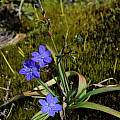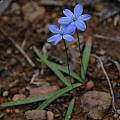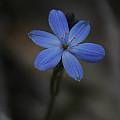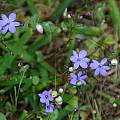Chamaescilla is a genus in the Anthericaceae family native to Australia. This family is included in Agavaceae or optionally in Asparagaceae by APG II. There are just a few species of plants with tuberous roots arranged around a compact corm-like stem. They have blue star-like flowers. The tuberous roots are replaced every year.
Chamaescilla corymbosa is found in damp sandy areas or rock in South Australia, Western Australia, New South Wales, Victoria and Tasmania in a variety of habitats: forest, woodland, heath. This species is 10 to 15 cm high. The bright blue star-like flowers have six tepals 8 to 10 mm long and grow on branched stems. They only last a day. Leaves are bluish green, arranged in a flat rosette in exposed places, but longer and erect in shaded conditions. There are three accepted varieties. Photos below were taken by Bob Rutemoeller and Mary Sue Ittner in southwestern Australia in September 2007. We believe it was this species, but did not attempt to break the plants any further. Plants were seen in a wet rock outcrop area along with orchids, in the forest, and in a wet area near a river where they were growing with spring annuals.
Chamaescilla gibsonii is native to southwestern Western Australia where it is found in winter wet flats and wet claypans.
Chamaescilla spiralis has similar flowers but leaves are spirally twisted and arranged in a loose tuft. It is found in southwestern Western Australia.



